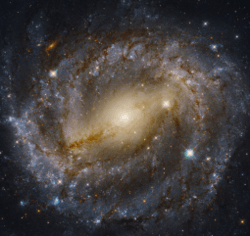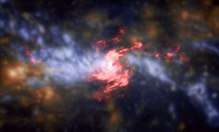NGC 5643
NGC 5643 is an intermediate spiral galaxy in constellation Lupus. It is located at a distance of circa 60 million light years from Earth, which, given its apparent dimensions, means that NGC 5643 is about 100,000 light years across. NGC 5643 has an active galactic nucleus and is a type II Seyfert galaxy.
| NGC 5643 | |
|---|---|
 NGC 5643 by Hubble Space Telescope | |
| Observation data (J2000 epoch) | |
| Constellation | Lupus |
| Right ascension | 14h 32m 40.7s[1] |
| Declination | −44° 10′ 28″[1] |
| Redshift | 1199 ± 2 km/s[1] |
| Distance | 55 Mly (16.9 Mpc)[1] |
| Apparent magnitude (V) | 10.7 |
| Characteristics | |
| Type | SAB(rs)c [1] |
| Apparent size (V) | 4′.6 × 4′.0[1] |
| Other designations | |
| ESO 272- G 016, MCG -07-30-003, PGC 51969[1] | |
Observation history
The galaxy was first reported by James Dunlop on May 10, 1826 with his 9-inch reflector telescope and described it as exceedingly faint. The galaxy was also spotted by John Herschel and added it in the General Catalogue of Nebulae and Clusters as number 3572. The galaxy is located only 15 degrees from the galactic plane.[2]
Structure
NGC 5643 is a grand design spiral galaxy, with two well-defined, symmetric arms. In the circumnuclear region are present and other dust spirals, but the two main dust arms are wider.[3] The galaxy is seen nearly face on, at an inclination of ∼ 27°.
Active galactic nucleus
The galaxy has a low-luminosity active galactic nucleus of Seyfert 2 type and is also a luminous infrared galaxy. The galaxy has a double sided diffuse radiojet. The galaxy exhibits an extended emission line region elongated in a direction close to the radio position angle of 87°±3°. Chris Simpson et al. analysed images takes from WFPC2 camera of the Hubble Space Telescope in [O III] λ5007 and Hα and found emission extending eastward for at least 1.8 kpc and in the [O III]/Hα map a well-defined V-shaped structure that they identified as the projection of a tridimensional ionisation cone, which shares the same axis with the radio emission. A dust lanes perpendicular to this axis obstructs the nucleus from direct view.[5] A disk of material was found when the data cubes of VLT were analysed. It is aligned with the nucleus and circles it and it possibly provides gas to the active galactic nucleus.[6] The mass of the supermassive black hole has been estimated based on the galaxy stellar velocity dispersion to be 106.4 M⊙.[7] It has been proposed that the gas outflow has led to star formation on two locations on the bar of the galaxy which lie at the location where the gas from the nucleus encounters the dense material of the bar.[8]
Via observations of the galaxy from XMM Newton telescope in 2009, the galaxy is found to be a Compton–thick active galactic nucleus. Also the galaxy emits soft X-rays, mainly from photoionized matter.[9] The prensence of the compton-thick column which obstructs the nucleus was confirmed from observations by NuSTAR.[10]
Ultraluminous X-ray source
In 2004, Guainazzi et al. detected in the images from XMM-Newton an ultraluminous X-ray source, named NGC 5643 ULX1, located within 0.8 arcminutes from the nucleus. The source outshined the nucleus in X-rays and if it is located within NGC 5643 its luminosity is over 1040 erg/s. Its luminosity is variable.[11] The X-rays could be produced either by an advection dominated disc or a Comptonising corona and the X-ray source considered to be a black hole of stellar origin of approximately 30 solar masses.[12]
Supernovae
NGC 5643 has been home of two supernovae, SN 2013aa and SN 2017cbv. SN 2013aa was discovered by Stuart Parker from New Zealand on a 30-s unfiltered CCD image taken on 13.621 UT February 2013, as part of the Backyard Observatory Supernova Search, at magnitude 11.9.[13] It was classified as a Type Ia a few days before maximum brightness.[14]
SN 2017cbv was discovered on March 10, 2017 by the Swope 1-m telescope at Las Campanas Observatory and was classified as a very young Ia supernova. It increased in magnitude from 15.8 to 14.8 within the next day.[15]
Nearby galaxies
NGC 5643 has a satellite dwarf galaxy, ESO 273-014.[16] NGC 5643 is the foremost member of a small galaxy group that also includes NGC 5530.[17]
References
- "NASA/IPAC Extragalactic Database". Results for NGC 5643. Retrieved 2016-01-18.
- O'Meara, Stephen James (2013). Southern gems. Cambridge: Cambridge University Press. p. 272. ISBN 978-1107015012.
- Martini, Paul; Regan, Michael W.; Mulchaey, John S.; Pogge, Richard W. (June 2003). "Circumnuclear Dust in Nearby Active and Inactive Galaxies. I. Data". The Astrophysical Journal Supplement Series. 146 (2): 353–406. arXiv:astro-ph/0212396. Bibcode:2003ApJS..146..353M. doi:10.1086/367817.
- "Hidden from view". www.eso.org. Retrieved 28 May 2018.
- Simpson, Chris; Wilson, A. S.; Bower, Gary; Heckman, T. M.; Krolik, J. H.; Miley, G. K. (January 1997). "A One‐sided Ionization Cone in the Seyfert 2 Galaxy NGC 5643". The Astrophysical Journal. 474 (1): 121–128. Bibcode:1997ApJ...474..121S. doi:10.1086/303466.
- Menezes, R. B.; da Silva, P.; Ricci, T. V.; Steiner, J. E.; May, D.; Borges, B. W. (16 April 2015). "A treatment procedure for VLT/SINFONI data cubes: application to NGC 5643". Monthly Notices of the Royal Astronomical Society. 450 (1): 369–396. arXiv:1504.02933. Bibcode:2015MNRAS.450..369M. doi:10.1093/mnras/stv629.
- Goulding, A. D.; Alexander, D. M.; Lehmer, B. D.; Mullaney, J. R. (21 July 2010). "Towards a complete census of active galactic nuclei in nearby galaxies: the incidence of growing black holes". Monthly Notices of the Royal Astronomical Society. 406 (1): 597–611. arXiv:1003.3015. Bibcode:2010MNRAS.406..597G. doi:10.1111/j.1365-2966.2010.16700.x.
- Cresci, G.; Marconi, A.; Zibetti, S.; Risaliti, G.; Carniani, S.; Mannucci, F.; Gallazzi, A.; Maiolino, R.; Balmaverde, B.; Brusa, M.; Capetti, A.; Cicone, C.; Feruglio, C.; Bland-Hawthorn, J.; Nagao, T.; Oliva, E.; Salvato, M.; Sani, E.; Tozzi, P.; Urrutia, T.; Venturi, G. (8 October 2015). "The MAGNUM survey: positive feedback in the nuclear region of NGC 5643 suggested by MUSE". Astronomy & Astrophysics. 582: A63. arXiv:1508.04464. Bibcode:2015A&A...582A..63C. doi:10.1051/0004-6361/201526581.
- Matt, G.; Bianchi, S.; Marinucci, A.; Guainazzi, M.; Iwawasa, K.; Jimenez Bailon, E. (2 August 2013). "X-ray observations of the Compton-thick Seyfert 2 galaxy, NGC 5643". Astronomy & Astrophysics. 556: A91. arXiv:1307.1591. Bibcode:2013A&A...556A..91M. doi:10.1051/0004-6361/201321293.
- Annuar, A.; Gandhi, P.; Alexander, D. M.; Lansbury, G. B.; Arévalo, P.; Ballantyne, D. R.; Baloković, M.; Bauer, F. E.; Boggs, S. E.; Brandt, W. N.; Brightman, M.; Christensen, F. E.; Craig, W. W.; Moro, A. Del; Hailey, C. J.; Harrison, F. A.; Hickox, R. C.; Matt, G.; Puccetti, S.; Ricci, C.; Rigby, J. R.; Stern, D.; Walton, D. J.; Zappacosta, L.; Zhang, W. (4 December 2015). "NuSTAR Observations of the Compton-thick Active Galactic Nucleus and Ultraluminous X-ray Source Candidate in NGC 5643". The Astrophysical Journal. 815 (1): 36. arXiv:1509.03322. Bibcode:2015ApJ...815...36A. doi:10.1088/0004-637X/815/1/36.
- Guainazzi, M.; Rodriguez-Pascual, P.; Fabian, A. C.; Iwasawa, K.; Matt, G. (November 2004). "Unveiling the nature of the highly obscured active galactic nucleus in NGC 5643 with". Monthly Notices of the Royal Astronomical Society. 355 (1): 297–306. arXiv:astro-ph/0408300. Bibcode:2004MNRAS.355..297G. doi:10.1111/j.1365-2966.2004.08317.x.
- Pintore, Fabio; Zampieri, Luca; Sutton, Andrew D.; Roberts, Timothy P.; Middleton, Matthew J.; Gladstone, Jeanette C. (11 June 2016). "The ultraluminous X-ray source NGC 5643 ULX1: a large stellar mass black hole accreting at super-Eddington rates?". Monthly Notices of the Royal Astronomical Society. 459 (1): 455–466. arXiv:1603.05542. Bibcode:2016MNRAS.459..455P. doi:10.1093/mnras/stw669.
- "Electronic Telegram No. 3416; SUPERNOVA 2013aa in NGC 5643 = PSN J14323388-4413278". Central Bureau for Astronomical Telegrams. Retrieved 12 March 2017.
- Sternberg, A.; Gal-Yam, A.; Simon, J. D.; Patat, F.; Hillebrandt, W.; Phillips, M. M.; Foley, R. J.; Thompson, I.; Morrell, N.; Chomiuk, L.; Soderberg, A. M.; Yong, D.; Kraus, A. L.; Herczeg, G. J.; Hsiao, E. Y.; Raskutti, S.; Cohen, J. G.; Mazzali, P. A.; Nomoto, K. (25 July 2014). "Multi-epoch high-spectral-resolution observations of neutral sodium in 14 Type Ia supernovae". Monthly Notices of the Royal Astronomical Society. 443 (2): 1849–1860. arXiv:1311.3645. Bibcode:2014MNRAS.443.1849S. doi:10.1093/mnras/stu1202.
- "ATel #10167: Swope Photometric Observations of SN 2017cbv = DLT17u". The Astronomer's Telegram. 11 Mar 2017.
- Karachentsev, Igor D.; Kaisina, Elena I.; Makarov, Dmitry I. (3 December 2013). "SUITES OF DWARFS AROUND NEARBY GIANT GALAXIES". The Astronomical Journal. 147 (1): 13. arXiv:1310.6838. Bibcode:2014AJ....147...13K. doi:10.1088/0004-6256/147/1/13.
- Makarov, Dmitry; Karachentsev, Igor (21 April 2011). "Galaxy groups and clouds in the local (z∼ 0.01) Universe". Monthly Notices of the Royal Astronomical Society. 412 (4): 2498–2520. arXiv:1011.6277. Bibcode:2011MNRAS.412.2498M. doi:10.1111/j.1365-2966.2010.18071.x.
External links
| Wikimedia Commons has media related to NGC 5643. |
- NGC 5643 on WikiSky: DSS2, SDSS, GALEX, IRAS, Hydrogen α, X-Ray, Astrophoto, Sky Map, Articles and images
